
What makes an epic fantasy series successful? The Dragon Prince has been so popular that its streamer, Netflix, committed to seven seasons—ordering the later four seasons all at once. So far the show has won a Daytime Emmy Award for Outstanding Animated Children’s Series, an IGN People’s Choice Award, two Kidscreen Awards, and a Leo Award for Best Direction in an Animated Series, with nominations in other categories. Season Five has just been released, continuing the struggles of Prince Callum the High Mage, Rayla the Moonshadow Elf, Soren the Crown Guard, a glow toad named Bait, and the Dragon Prince himself, Azymondias, seeking to stop the emergence of Aaravos, a powerful Startouch Elf who threatens the land of Xadia. Also seeking Aaravos: Claudia, a dark mage and her Earthblood Elf friend Terry, to restore her comatose father, Lord Viren, back to full health before he expires in 30 days.
Complex? Yes. This is, after all, an epic saga. Netflix, Wonderstorm and Bardel Entertainment want to appeal to a general audience, without “dumbing down” the material.
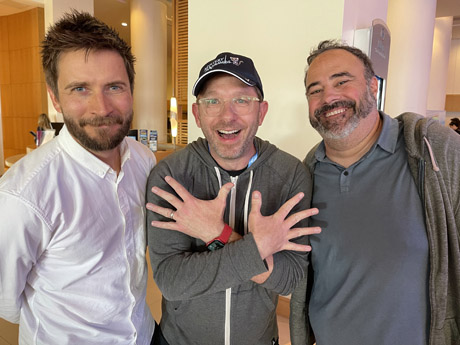
The Dragon Prince showrunners: (L-R) Villads Spangsberg, Aaron Ehasz, Justin Richmond.
On July 21, I spoke with co-creators Aaron Ehasz and Justin Richmond, with executive producer Villads Spangsberg, at San Diego Comic-Con. We talked about two key ingredients, attention to detail and gutsy storytelling in making their story an epic. Plus, the value of Spangsberg to the team and the importance of Season Five.
“We wanted to tell a story in a world that was even bigger than the story,” Aaron Ehasz says. “As you got to the edge of this fantasy, you could see miles and miles of more dimensions and intrigue just beyond where you’ve traveled. We wanted that feeling of immense scale, both in terms of the place Xadia and the timeline and the history and the things we were building. I don’t know why. It just seems fun to build something like that. We got really lucky we came to Netflix at the minute we did and met the people who were excited to give us the chance to build something that was that epic.”
This epic world is rendered in staggering detail, from the scales of the dragons’ bodies to the floral patterns on Soren’s pajamas. In traditional hand-drawn animation, it would take a huge amount of time to draw, and for the animator to convey behavior, expressions, posing and timing, all the while staying “on model.” This would require an enormous budget—and schedule—comparable to a feature film. The Dragon Prince accomplishes these details without sacrificing performance, and on a more economical budget. The approach involved rigging and animating characters in Maya 3D, then using a “cel-shading” program to “flatten” the image to a more traditional-animated aesthetic.
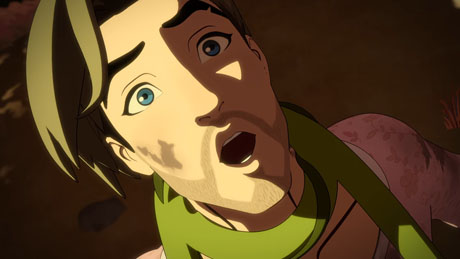
Can you imagine drawing all that facial stubble and floral patterns, frame by frame by frame?
To do the actual production, Ehasz and Richmond approached Bardel Entertainment in Canada, founded by Barry Ward and his wife, Delna Bhesania, from which the studio name is derived. Bhesania was President and CEO at the time.
Richmond recalls, “When Delna came to visit us in our tiny office, we had a pitch deck that had all kinds of visuals in it, and we were just talking about the show. She was like, ‘Well, this sounds awesome and it sounds very expensive.’—Richmond laughs—‘How have you been thinking about doing it?’
“They just done this movie called The Prophet, where they had done a lot of this very particular look. And we saw it. And she was like, ‘What about something like this?’

The Dragon Prince (L to R) Jesse Inocalla as Soren, Sasha Rojen as Ezran and Omari Newton as Corvus in The Dragon Prince. Cr. COURTESY OF NETFLIX © 2023
“‘Yeah, that’s awesome. Can you guys actually hit the fidelity of a 90-minute movie for the show?’
“She was like, ‘Yeah, we can do that.’ And so, she was the impetus of where it came from,” Richmond says.
Enter Villads Spangsberg. Hailing from Denmark, he had served as showrunner, Supervising Director, and Senior Art Director for the Lego Group for six years before joining Bardel Entertainment as Series Director in January 2017.
“I was hired by Barry and Delna,” he says. “They always promised me there would be a cool show at some point. ‘Just hang out some day; we’ll get your really cool show.’ And I had been there for four or five months and a bunch of really cool Americans came up to pitch the little show.
“I was lucky enough to be introduced to Giancarlo [Volpe, director], Aaron and Justin and Justin [Santistevan, President and co-founder, Wonderstorm]. I knew how the machine was working. I knew where to run around with the oil can, which gears had to be oiled a little bit more than others to make the machine perform, basically to take the vision that Aaron and Justin had and bring that to life on screen. Not necessarily infusing my own creative that much at the beginning because you guys [Ehasz and Richmond] had a very strong bible; you had a very strong idea what you want to do. Giancarlo had a strong idea about the style of animation and the Miyazaki-ish look of the show.
“The challenge was to take 220 people and explain to them how to do something that looks quite different, that’s animated differently—which was a bit of a learning curve. And I think that was maybe what sold me to you guys [Ehasz and Richmond].”
“You also have an awesome reel and you’ve done all kinds of cool stuff,” Richmond says.
Spangsberg adds, “I’ve done a few shows in the past with Studio Mir. I worked at Lego for a long time. So, I knew our target audience, and I had a passion to do something of high quality. That was the chance to jump on this project. It was not just the usual preschool sausage production. It was like, ‘This is gonna be hard, but it’s gonna be a very great challenge.’”
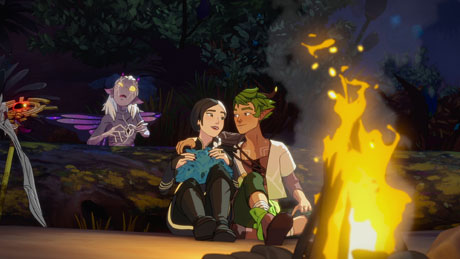
The Dragon Prince (L to R) Racquel Belmonte as Claudia and Benjamin Callins as Terry in The Dragon Prince. Cr. COURTESY OF NETFLIX © 2023
“I would say,” Ehasz says, “what was clear about Villads that set him apart was that in addition to knowing how productions work and knowing how to make a thing and having high aspirations for high quality, he had a clear creative edge—which is to say when we talked to him, he just had a spark and an interest in elevating things. And he had his own approach and his own ideas. And he had a cinematic eye. He cared about film and how, and he thought of animation as filmmaking. It was clear that this was someone who was gonna elevate the work in addition to organizing the team. But what we didn’t know until after having worked with him for all that time was that he is an inspirational leader. So the role of having to work with 200 people in Vancouver who are working really hard day in and day out to put together all the pieces of a complicated production, to have this role of making sure they’re holding it together, but also that not only that they’re feeling good, but that they’re feeling inspired to do their best work, to do work that will be meaningful.”
“It’s not a small production where you have 200 people,” Spangsberg says. “You can engage people by building trust and passion for ownership and the freedom to let animators take what the storyboard artist did and plus it and come up with alternatives that builds so much passion because they feel it’s theirs. They’re not just sitting there doing other people’s work, right? So, honestly again, in the morning I’ll be walking around with a cup of coffee and looking over the shoulder, around 60 animators, and talk to them about the scene that they were doing, but really try and listen to what they wanted to do with the show because if you can make them excited about it, it’s gonna help you, a lot. And it’s gonna make it to the screen. Unfortunately, in the industry, there’s a lot of tyrants at the top that it’s like, it’s my show. I don’t like it like that.”
Says Ehasz, “It was really amazing to watch how Villads brought the best out of people and made them feel good about what they were doing. They felt they were doing something meaningful. So he’s just an incredible creative leader and we’re grateful that we’ve had him since the beginning.”
Spangsberg worked on The Dragon Prince as Supervising Director for the first three seasons, after which he served as Executive Producer for the Lego Group in Los Angeles for a year and ten months. And then, Wonderstorm hired him for Seasons Four and beyond as Executive Producer, a position he’s served since May 2021.
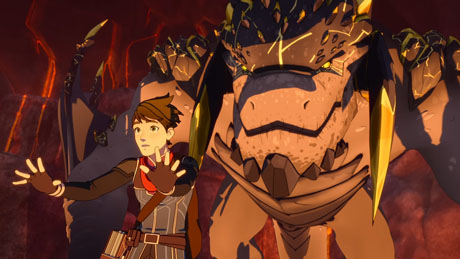
Imagine animating all these details while keeping the characters “on model” on a TV budget.
For the production pipeline, Spangsberg maximized the benefit of the 3D cel-shading approach.
“The advantages of doing something like this,” he says, “is you can add more detail, more line work, pen mileage that you would do in a 2D show. Because you’re not drawing every single line. But there’s a fine line between the soft cel-shaded 2D look and the more source CG semi- rendered. You have to find that the chair you want to sit on so you don’t fall in-between. Right?
“We wrote a strict bible with how light was falling on the characters, and how we animated the characters. A lot of the 2D effects explosions and smears were all drawn by hand. Again, if you animate “on ones,” like 24 frames a second, you have to also have a 2D artist then draw 24 frames. So the show becomes exponentially more expensive to do than the slightly more Korean, anime-inspired direction of animation “on twos and threes.” You can certainly have a more 2D effects and you can get that epic feeling for less money.
“We had a strong team of 60 animators who could animate in CG. We didn’t necessarily have a 2D animation team. You can get a lot of great animation with CG in a short period of time, where we actually can have a little bit more in-between movement.”
Nuanced acting is noticeable for the characters, which raises the question: does the production team use any kind of motion capture? (As is done in Studio Orange’s Beastars. See here and here).
“No, but we use reference,” Spangsberg says. “All the directors and all the animators and board artists, we record reference, because it is slightly live-action-y. We don’t cut unless you have to cut. Stay in the shot as long as you can until there’s a reason to cut. It’s for the same for acting. Don’t have characters move around unless you would do it in real life. Right now, we’re sitting down and just like nodding our heads. So, do that. Right?”
The Dragon Prince has undergone a remarkable improvement in the frame rate since the first season, where character movements were noticeably choppy. In later seasons, characters don’t pop so much, if at all, allowing viewers to be more fully immersed in the story and action.

“At Bardel we were a little too naive in terms of training, again, 60 people that comes from fully splined, fully smooth [motion] into understanding the strong posing and not having characters move all the time,” Spangsberg says. “If you look at anime, the character don’t move much because it gets sort of flicker, ‘cause you can only do so many frames a second on the budget you have. But we also had the characters move little too much, and then we don’t have enough in-betweens.
“So we’re trying to be bold with our stylistic choices and then we didn’t really train the people properly. We were trying to be adventurous. We tried to do something new and when we you make something new, you make mistakes, right?
“The good news is that team got up to speed and I think throughout the first season, the episodes got better and better. First episode actually was quite good, but also that wasn’t the first one we did. You never do the first episodes as the first one. So yeah, I think it was a little bit of a learning curve and just adjusting the sensibilities.
“You also listen to the fans. You listen to the audience and at the end of the day, we make a show for a pretty big audience, and we need to make sure that the stylistic choices don’t take you out of it. That it’s not like, “Oh man, it’s so cool, ‘cause we are like, ‘we only animate on fours, man, it’s so cool’,” Spangsberg says.
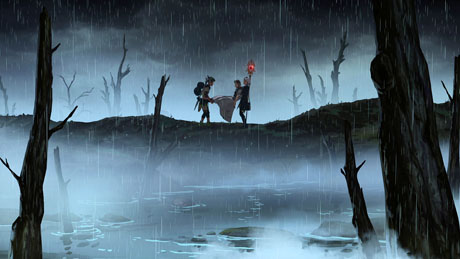
The Dragon Prince – Cr. COURTESY OF NETFLIX © 2023
Another improvement in Season Five is the cinematography, how scenes are lit and colored. This is particularly noticeable in Sol Regem’s cave, Finnegrin’s Sea Legs vessel, and the atmosphere of the relatively lawless town of Scumport. Or with Finnegrin’s shadow sliding into his cabin “on ones.”
“Yeah, we push for that whenever we can,” Spangsberg says. “Again, as long as it serves the story, throw a big, daunting light behind the bad guy. Right? Have him silhouetted. One thing we do a lot actually, is that if you watch the show, you’ll notice that if a character has a bit of a flaw building up, like if he’s making a bad decision, it could be a good guy. It could be Callum making a bad decision. It could be Ezran. We backlight them or have them a little bit in shadow.”
“You’re giving away our secrets, Villads,” Richmond says with a laugh.
Says Spangsberg, “If you watch the show, you’ll know we paid attention to where the light was being placed. Sometimes the light is inconsistent in the scene because we wanted to show the story, but not necessarily the logic of like, ‘Oh, there’s a light bulb there.’ Right? Sometimes it’s accidents, to be honest. You see something and you’re like, ‘Oh, this is totally wrong.’ But it totally works.”
To be continued.
Next: Gutsy storytelling.
* * *
Special thanks to Jennifer Greene of Illuminate-Communications.
The Dragon Prince, Seasons One, Two and Three, and The Dragon Prince: Mystery of Aaravos, Seasons Four and Five, are currently streaming on Netflix.
- INTERVIEW: Aaron Ehasz, Justin Richmond on “The Dragon Prince: Mystery of Aaravos”: The Right Choice for the Voice - March 20, 2024
- INTERVIEW: “The Dragon Prince” Influences, Inspirations, and the Mystery of Simpson - March 11, 2024
- INTERVIEW: The Magic of Her Voice: Paula Burrows of “The Dragon Prince” - October 4, 2023


 July 31st, 2023
July 31st, 2023  W.R. Miller
W.R. Miller  Posted in
Posted in  Tags:
Tags: 






